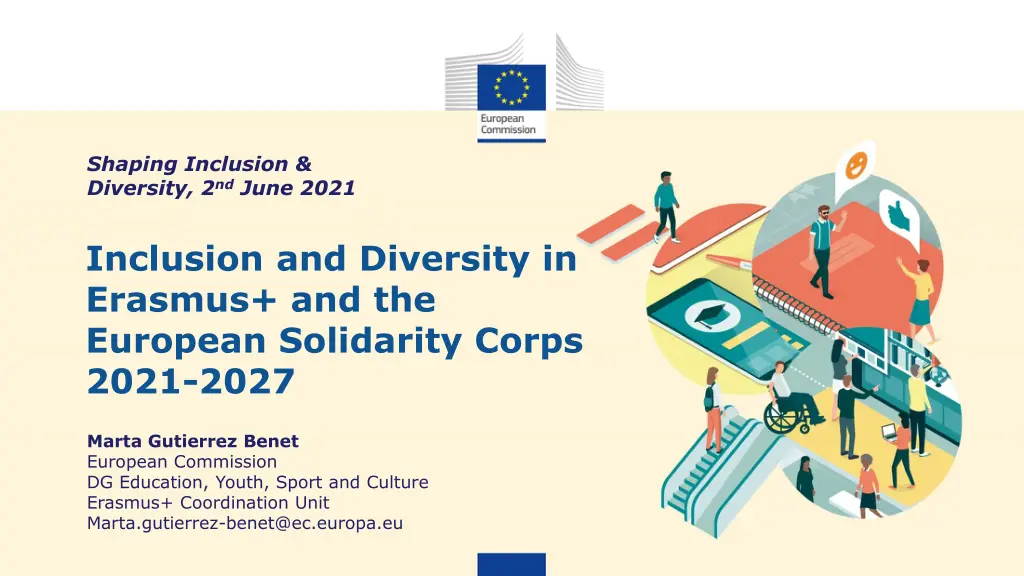
Enhancing Inclusion and Diversity in Erasmus+ and European Solidarity Corps
Explore the key transversal priorities and regulations for promoting inclusion and diversity in Erasmus+ and the European Solidarity Corps programs. Understand the harmonized definitions and barriers that hinder participation, aiming to create a more accessible and sustainable environment for all. Learn how frameworks of inclusion measures and national plans contribute to fostering equality and opportunities for individuals facing various obstacles.
Download Presentation

Please find below an Image/Link to download the presentation.
The content on the website is provided AS IS for your information and personal use only. It may not be sold, licensed, or shared on other websites without obtaining consent from the author. If you encounter any issues during the download, it is possible that the publisher has removed the file from their server.
You are allowed to download the files provided on this website for personal or commercial use, subject to the condition that they are used lawfully. All files are the property of their respective owners.
The content on the website is provided AS IS for your information and personal use only. It may not be sold, licensed, or shared on other websites without obtaining consent from the author.
E N D
Presentation Transcript
Shaping Inclusion & Diversity, 2nd June 2021 Inclusion and Diversity in Erasmus+ and the European Solidarity Corps 2021-2027 Marta Gutierrez Benet European Commission DG Education, Youth, Sport and Culture Erasmus+ Coordination Unit Marta.gutierrez-benet@ec.europa.eu
Key transversal priorities for the new Programmes Making Erasmus+ a more environmentall y sustainable programme and fostering sustainable behaviours Offering a more inclusive and accesible programme Promoting the use of digital tools and the development of digital skills Enhancing active participation in the programme and in society
The Erasmus+ and European Solidarity Corps regulations contain references to: A Framework of Inclusion Measures to be developed and adopted by the Commission within 6 months of the entering into force of the regulations, and establishing the main lines of work for the next 7 years in the area of inclusion and diversity. Concrete guidance for implementation that is flexible and adaptable, building on and incorporating work done in co-creation with the relevant stakeholders (e.g., the annual Implementation guidelines for the Erasmus+ and European Solidarity Corps Inclusion and Diversity Strategy Implementation guidelines for the Erasmus+ and European Solidarity Corps Inclusion and Diversity Strategy Call for Proposals, the programme Guide, Guide for NAs, the Guide for experts, and the Implementation guidelines for the Erasmus+ and European Solidarity Corps Inclusion and Diversity Strategy) ; The National inclusion plans elaborated as an integral part of each National Agency s work programme.
Harmonised definitions for both programmes: 'people with fewer opportunities' means people who, for economic, social, cultural, geographical or health reasons, due to their migrant background, or for reasons such as disability or educational difficulties or for any other reason, including a reason that could give rise to discrimination under Article 21 of the Charter of Fundamental Rights of the European Union, face obstacles that prevent them from having effective access to opportunities under the Programme.
Barriers that can hinder participation (alone, or as a combination of several barriers): Disabilities Health problems Barriers linked to education and training systems Cultural differences Social barriers Economic barriers Barriers linked to discrimination Geographical barriers
Reference documents that support the implementation of I&D The Implementation Guidelines for the Erasmus+ and European Solidarity Corps Inclusion and Diversity Strategy The Programme Guides The Guides for experts Contain narrative introductions on the importance of I&D as integral part of funded projects Present priorities, criteria and funding mechanisms Highlights the importance of I&D supports evaluators in the identification of potential best practice projects shared definitions across the different sectors, target groups and specific inclusion-related objectives description of the measures available for organisations and participants within the programmes, to ensure their broadest accessibility guidance for National Agencies, Resource Centres and the European Education and Culture Executive finding inspiration and best practices in the area of inclusion and diversity within Erasmus+ and the European Solidarity Corps Agencysources for
The national inclusion plans Outreach to target groups particularly relevant in the national context Information and awareness raising activities Supportive approach Strategic action Inclusion officers and internal structures Monitoring Synergies with other programmes Some content areas for inspiration (based on 2021 Guidelines)
Based on these elements Constant exchange Nas, SALTO and COMM Monitoring and reporting activities Communication and promotion about a strong I&D dimensi n Development of inclusion plans by Nas Training and development in I&D
